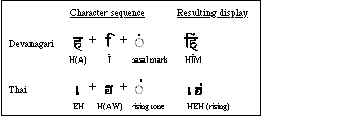Legacy Document
Important: The information in this document is obsolete and should not be used for new development.
Important: The information in this document is obsolete and should not be used for new development.



For Arabic and Hebrew, there are three conventions for the order in which text is encoded:
Unicode uses implicit order, with the addition of optional controls for unusual cases or fine-tuning, and specifies the reordering algorithm for display. The Windows and Mac OS Hebrew and Arabic encodings also assume implicit order. Figure B-8 gives an example of implicit ordering.

Characters that are otherwise identical in different character encodings may have different direction attributes in the two encodings, and this creates another "fuzzy" problem for matching character repertoires. For example, Unicode has a single PLUS SIGN character, with direction class European Number Terminator; the Mac OS Hebrew and Arabic encodings have two plus sign characters, one with strong left-right direction, and one with strong right-left direction. This is because the Mac OS encodings were designed in 1986 for a reordering model that was less sophisticated than the current Unicode reordering model.
There are also two different ordering conventions for characters in Indic and related Southeast Asian scripts. In these scripts, consonants have an inherent vowel, which is pronounced after the consonant. A vowel mark may be used with the consonant to change the vowel; this vowel mark may be displayed above, below, to the left or to the right of the consonant; it may even surround the consonant or have components that appear on either side.
The scripts of India are generally encoded in logical order, so that any dependent vowel (and other marks related to the consonant) follows the consonant in memory. The consonant, together with any dependent vowel and other marks, constitutes a «consonant cluster». Successive clusters are displayed in left-to-right order, but within a cluster the ordering may be complex. (Clusters may also include vowel-less dead consonants that precede the main consonant.)
Thai consonants have an inherent tone as well as an inherent vowel; tone marks may be added to change the tone, in addition to any vowel signs. Thai is generally encoded in visual order, unlike the scripts of India, so a vowel that modifies a consonant's inherent vowel may precede or follow that consonant in memory.
Unicode follows the above conventions for encoding Indic and Thai (Lao is related to Thai, and is encoded similarly).
Figure B-9 Character sequence and resulting display
